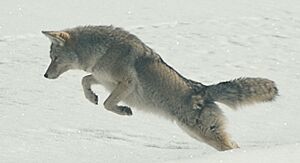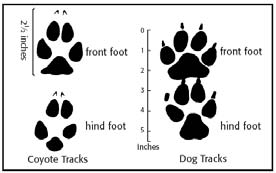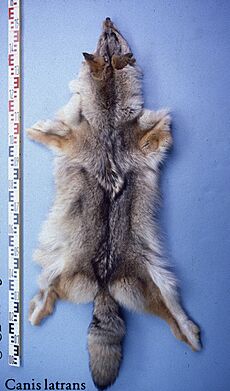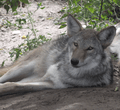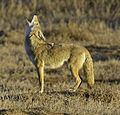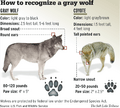Coyote facts for kids
Quick facts for kids CoyoteTemporal range: Middle Pleistocene – present (0.74–0.85 Ma)
|
|
|---|---|
 |
|
| Mountain coyote (C. l. lestes) at Yosemite National Park, California | |
| Conservation status | |
| Scientific classification | |
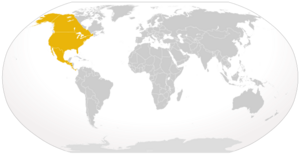 |
|
| Modern range of Canis latrans | |
| Synonyms | |
|
List
|
The coyote (Canis latrans) is a type of wild dog that lives in North America. It is smaller than its relatives, the gray wolf, eastern wolf, and red wolf. Coyotes are similar to golden jackals found in Europe and Asia. People sometimes called them the "American jackal" or "prairie wolf."
Coyotes are very common and live across North America. They are listed as "least concern" by the International Union for Conservation of Nature because there are so many of them. These animals are very good at adapting and can even live in cities. In 2013, coyotes were seen for the first time in eastern Panama.
There are 19 different types, or subspecies, of coyotes. Male coyotes usually weigh between 8 to 20 kg (18 to 44 lbs), and females weigh 7 to 18 kg (15 to 40 lbs). Their fur is mostly light gray and reddish-brown, mixed with black and white. Coyotes can live alone or in small family groups. They mostly eat meat, like deer, rabbits, rodents, birds, and fish. Sometimes, they also eat fruits and vegetables. Coyotes are known for their special howl. People are the biggest threat to coyotes, along with cougars and gray wolves. Even though wolves sometimes hunt coyotes, coyotes can also mate with wolves, creating "coywolf" hybrids. Many wolves in North America have some coyote DNA.
Coyotes are important characters in Native American stories, especially in the southwestern United States and Mexico. They are often shown as tricksters who can change between being a coyote and a man. These tricksters use cleverness and humor to challenge rules. In ancient Central America, coyotes were a symbol of military strength. After Europeans came to the Americas, coyotes were often seen as cowardly animals. While people's views on wolves have improved, coyotes are still often seen in a negative way.
Contents
What Coyotes Look Like
Male coyotes typically weigh 8 to 20 kg (18 to 44 lbs), and females weigh 7 to 18 kg (15 to 40 lbs). Coyotes in the north are usually larger than those in Mexico. An adult coyote is about 1.0 to 1.35 meters (3.3 to 4.4 feet) long, including a tail that is about 40 cm (16 inches) long. The largest coyote ever recorded was 1.5 meters (5 feet) long and weighed 34 kg (75 lbs)! Coyotes have special scent glands at the base of their tail.
The color and feel of a coyote's fur can change depending on where it lives. Their fur is mostly light gray and reddish-brown, with black and white hairs mixed in. Coyotes living in mountains often have more black and gray fur. Those in deserts are more reddish or whitish-gray. Their fur has a soft undercoat and long, coarse guard hairs. Coyotes in colder northern areas have longer, thicker fur. Very rarely, coyotes can be albino (all white).
Coyotes are usually smaller than gray wolves. They have longer ears and a larger skull compared to their body size. Their bodies, faces, and muzzles are also thinner. Unlike wolves, coyotes carry their tail pointing downwards when they run or walk.
You can tell coyote tracks apart from dog tracks because coyote tracks are longer and less round.
Where the Name "Coyote" Comes From
The word "coyote" comes from the Nahuatl language, spoken by the Aztec people, where it was coyōtl. The first time the word "coyote" was written in English was in 1824. By the 1880s, the spelling "coyote" became standard.
People say "coyote" in two ways: with two syllables (COY-ote) or three syllables (COY-o-tee). The three-syllable way is more common in eastern states and near the Mexican border.
Other names for the coyote include "prairie wolf" and "brush wolf." Its scientific name, Canis latrans, means "barking dog," which makes sense because they make many different sounds!
Where Coyotes Live
Coyotes live only in North America and some parts of Central America. They can be found in the countryside, but also in cities. Coyotes live all over North America, from California up to Alaska. They usually live in dens that are about 1.8 meters (6 feet) wide and 1.2 meters (4 feet) tall.
Coyote Life and Habits
Coyotes are omnivores, meaning they eat both plants and animals. In fall and winter, they eat fruits, grasses, and vegetables. They also hunt small animals like rabbits, mice, and voles. They can also eat birds, deer, snakes, and lizards. In cities, coyotes easily find food. They might dig up plants in gardens or eat food from garbage cans.
Coyotes usually hunt alone, but sometimes they join small groups called packs. They live in dens, which are tunnels dug underground with a larger area at the end. This is where they sleep and have their babies, called pups. A female coyote can have up to six pups at a time. Coyote dens often have two entrances, with one being hidden. They sometimes dig more than one den so they can move if an enemy finds their first home.
Coyotes do not have many natural enemies. Wolves used to hunt coyotes, but there are fewer wolves now. The biggest threat to coyotes is people. Coyotes usually do not attack people, but they might sometimes eat small pets like cats.
Coyotes in Stories and Myths
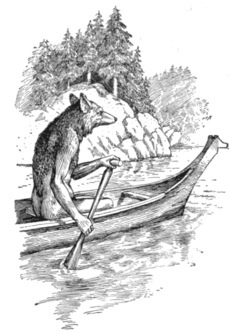
Coyote is a popular trickster character in the folktales of many Native American groups, especially in the Southwest and Plains regions. In these stories, Coyote often changes between being an actual coyote and a man. Like other tricksters, Coyote is a clever hero who uses tricks and humor to go against social rules. People believe coyotes became tricksters in stories because they are smart and can adapt well. After Europeans came to America, stories about coyotes in Anglo-American culture often showed them as cowardly and untrustworthy. While people's opinions of gray wolves have improved, coyotes are still often seen in a negative light.
In some Native American creation stories, Coyote plays a big role. For example, in the Maidu creation story, Coyote brings work, suffering, and death into the world. The Zuni say Coyote brought winter by stealing light. The Crow creation story says Old Man Coyote is The Creator. In the Dineh creation story (Navajo), Coyote was present when the world was made. The Navajo Coyote also brings death to the world, explaining that without death, there would be too many people and not enough food.

Before the Spanish conquest of the Aztec Empire, coyotes were very important in ancient Central American beliefs. In the ancient city of Teotihuacán, the coyote symbolized military power. Warriors would dress in coyote costumes to feel its strength. This link between coyotes and warriors continued for centuries.
In Aztec mythology, Huehuecóyotl, the god of dance, music, and fun, is shown as a man with a coyote's head. Some experts believe the god Quetzalcoatl might have come from older stories about the coyote, which was seen as mankind's "Elder Brother" and a creator.
Coyote Tracks and Hunting
Coyote hunting is a common activity for humans. There are not many rules about hunting coyotes, so many different methods are used, such as trapping and using calls to attract them. Coyotes are colorblind, meaning they only see shades of gray and subtle blues.
Coyote footprints are oval-shaped, about 6.35 cm (2.5 inches) long and 5.08 cm (2 inches) wide. They have four claws on both their front and back paws. The center pad of their paw is shaped like a rounded triangle. Like domestic dogs, a coyote's front paw is slightly larger than its back paw.
Coyote Fur
Before the mid-1800s, coyote fur was not considered valuable. But after beavers became scarce, coyote fur became important. By 1860, hunting coyotes for their fur was a good way for hunters in the Great Plains to earn money. Coyote pelts were very important for the economy in the early 1950s, costing between $5 and $25 each. Coyote fur is not strong enough for rugs, but it is used for coats, jackets, scarves, and muffs. Most pelts are used for trimmings on women's clothing, like collars and sleeves. Sometimes, coyote fur is dyed black to look like silver fox fur.
Historically, trappers and mountain men sometimes ate coyotes during the western expansion. Coyote pups were also eaten by some indigenous people in California. The taste of coyote meat has been compared to wolf meat and is more tender than pork when boiled. Coyote fat, collected in the fall, was sometimes used to grease leather or eaten as a spread.
Can Coyotes Be Tamed?
Coyotes were likely partly tamed by some ancient cultures before Europeans arrived. Some writers from the 1800s wrote about coyotes being kept in Native American villages. A coyote pup can be easily tamed, but as it grows up, it might become destructive. Both purebred coyotes and coyote-dog hybrids can be playful and trusting with their owners. However, they are usually shy and suspicious of strangers. There have been stories of tamed coyotes being used for tasks like retrieving items. A tame coyote named "Butch" even appeared in movies in the 1940s before it was shot for raiding a chicken coop.
Images for kids
-
Toltec pictograph of a coyote
-
Skeleton of Pleistocene coyote (C. l. orcutti)
-
An urban coyote in Bernal Heights, San Francisco
-
Mountain coyotes (C. l. lestes) cornering a juvenile cougar
See also
 In Spanish: Coyote para niños
In Spanish: Coyote para niños




